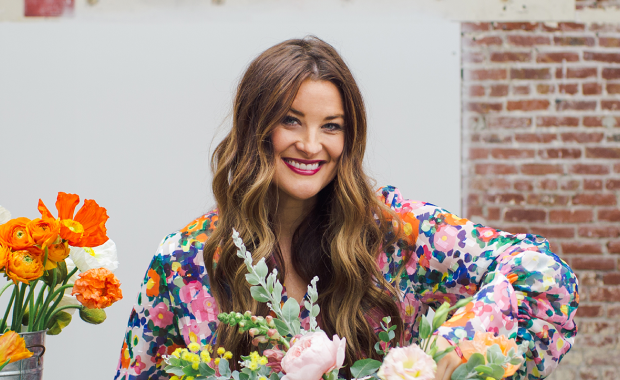November 18, 2025
What luxury brands know about customer service that everyone else is learning
An insider conversation with Maria Elias, luxury CX expert at Inktel Contact Center Solutions
The boots weren't going to make it.
A VIP client's milestone birthday trip was days away, and the statement boots she'd ordered, the centerpiece of her carefully planned outfit, were stuck in transit. She was devastated.
Most customer service teams would have apologized, offered a refund, and moved on. But Maria Elias's brand ambassador (BA) at Inktel saw something different. An opportunity to turn a crisis into a moment the client would never forget.
Within hours, the BA had done something remarkable. She didn't just solve the problem, she reimagined it. After asking where the party was, what the theme was, and what the client had envisioned wearing with those boots, she curated an entirely new birthday look. Statement shoes that fit the theme even better, a bold jacket, and a show-stopping hat. Everything was shipped directly to the destination, arriving just in time.
The client's response? Pure delight. What started as a missed delivery became a full styling moment…and a customer for life.
"That's the power of human connection," says Maria Elias, Account Executive at Inktel, where she leads a portfolio of luxury brand accounts spanning iconic department stores, high-end beauty retailers, and global fashion houses. "It doesn't just save a sale. It creates loyalty."
With Get to Know Your Customers Day approaching on October 16, a quarterly reminder for businesses to deepen customer relationships, Maria's insights feel especially timely. But for luxury brands, she notes, knowing your customers isn't a quarterly initiative. It's the foundation of everything.
After nearly two decades in luxury fashion, including 12 years in New York City, Maria has developed a philosophy that's equal parts intuition and strategy: "You've got to be nosy in a good way," she says. "Ask thoughtful, exploratory, open-ended questions and then remember the details. The beauty is in the details."
Now, as luxury service principles scale across industries, from airlines to tech companies, and AI transforms how brands remember and act on those details, Maria's approach offers a roadmap for any business that refuses to compromise between efficiency and personalization.
We sat down with Maria to talk about what luxury service really means, how to train teams to deliver it, and why the future belongs to brands that master both technology and humanity.

Maria Elias, Account Executive, Inktel
Let's start with fundamentals. What's the difference between premium service and luxury service?
Maria Elias (ME): Premium service is about accessibility. It's the baseline and standard. It meets expectations but doesn't necessarily exceed them.
Note.
Luxury service, on the other hand, is rare and deeply personal. It's intentional, emotional, and time-intensive. It requires empathy, creativity, and storytelling. Luxury clients don't just want efficiency; they crave care, personalization, and experiences that feel tailor-made just for them.
I'll give you a personal example. After returning from maternity leave, I had an appointment with a brand, and I'll never forget how their account manager greeted me. She had my favorite drink and snacks waiting, knowing I was nursing and would need the energy for our long meeting. She even curated a coloring book for my daughter. I was so moved. It was one of the most thoughtful gestures I've ever experienced. She made me feel genuinely seen, cared for, and celebrated.
That moment stays with me, and it inspires me to extend the same level of care, not just to clients, but in everyday life.
You often describe luxury service as "the difference between a buffet and a curated dinner party." Can you unpack that?
ME: At a buffet, everything's laid out. You serve yourself. It's efficient, but there's no personalization. A curated dinner party, though? Your host has thought about every detail. Your glass is topped off before you notice it's empty. Your chair is pulled out before you sit. The meal is tailored to your preferences, maybe even dietary needs you mentioned months ago.
That's luxury service. It's seamless. It's invisible care. Anticipating needs before customers voice them.
Here's what that looks like in practice:
Simply saying "Happy Birthday" or "Happy Anniversary." It's effortless, yet deeply meaningful. When was the last time someone said those words to you and it didn't make you smile? These small gestures remind the client that they're genuinely remembered, not just recorded in a database.
If a client prefers a follow-up email after a call with a recap or helpful links, do it proactively. Don't wait for them to ask. These small gestures build trust and show that you're truly listening.
A handwritten note or thoughtful text when a client's package arrives. Wishing them a great trip, inviting them to share photos, or following up afterward to ask how it went, these are the kinds of small, unexpected gestures that create real moments of surprise and delight.
These aren't expensive. They're intentional.
Let's talk about training. You run something called the Fashion District immersion in Miami twice a year. What makes it special?
ME: It's not just a store visit, it really feels like a masterclass in luxury retail. We bring our Brand Ambassadors together for a full day of training: half in the classroom for hands-on skill-building, and half in-store for full brand immersion.
BAs step into the shoes of a client, experiencing what it feels like when service goes above and beyond. They try on products, explore sizing, and appreciate the craftsmanship of luxury leather goods. Some of our favorite moments are when they're holding an item and suddenly get it. They understand why a client would fall in love with this piece.
Each BA is given a faux client profile and tasked with creating personalized looks. The store becomes a classroom where they practice "daring to propose" with intention. The energy is contagious. Everyone leaves inspired, confident, and motivated to bring that same magic to real clients.
And the business results back it up.
We see an immediate uplift in sales, with conversion rates increasing by an average of 3-4%. Agents become noticeably more confident, energized, and motivated. Client surveys reflect this shift, with more frequent praise for agents' product expertise and accurate size recommendations.
When agents are well-versed in sizing, especially drawing from their own experience, it significantly reduces return rates and enhances overall customer satisfaction.
That's compelling ROI. But training alone doesn't create lasting relationships. What happens when luxury clients feel truly recognized?
ME: Everything changes. They trust you more, they're quicker to reach out, and they share personal milestones. Whether it's an anniversary, a birthday trip, or a special event they need styling for. That trust creates space for honesty, making it easier for Brand Ambassadors to recommend pieces we know they'll love.
Recognition isn't just about service; it's about creating relationships that last. A solid relationship is the root to a lifelong, loyal client.
Story time.
Take the boots client I mentioned earlier. After that birthday styling moment, she started reaching out via SMS regularly, keeping us informed about upcoming events in her life where she'd like styling support.
We've also connected with one of her friends regarding events at her favorite boutiques, which beautifully illustrates the collaborative spirit between our client services team and the brand. We have the same goal: make every client feel exceptional.
It’s proven by numbers. Increasing customer retention rates by just 5% can increase profits by 25% to 95%. In luxury retail, where customer lifetime value can reach five figures or more, those relationships compound quickly.
Social media has changed how luxury customers shop. How has that shifted expectations?
ME: When I started in luxury fashion, discovery meant flipping through WWD or traveling to department stores just to window shop. It was slower, more tactile, and a little mysterious. It was the thrill of the hunt.
Now, social media has revolutionized the experience. Customers across the world can access Fashion Week moments, product launches, and styling inspiration instantly. Many clients call us already knowing exactly what they want, after weeks, sometimes months, of building their wishlists online. They arrive informed, inspired, and ready to buy.
That creates a double-edged sword. Yes, there are times when an item sells out, especially when it goes viral. While that can be disappointing for the client, it's also a valuable opportunity.
We use these moments to invite them to subscribe to our newsletter, join our loyalty program, and most importantly, to deepen their connection with the brand. Rather than focusing solely on the sold-out item, we take the chance to showcase similar pieces and offer a curated "tour" of the brand, highlighting what makes it truly special beyond a single product.
The expectation now is for service to match the speed of social media while maintaining that personal touch. That's where AI becomes essential.
Let's talk about AI. What role should it play in luxury customer experiences?
ME: AI is an incredible tool for uncovering client rhythms. It can recognize what they love, when they tend to shop, and how their preferences evolve. That insight lets us anticipate needs, personalize outreach, and even celebrate milestones at just the right time.
But here's what's critical.
AI doesn't replace the human touch. It makes life easier for agents and elevates the client experience. When AI handles the heavy lifting, associates have more time to focus on what really matters: making people feel seen, valued, and taken care of.
We've leveraged AI to review client purchase history, helping us avoid the frustrating misstep of recommending the same item twice. It can feel impersonal when an associate offers something you've just bought or already declined.
With AI, we sidestep that by recommending fresh, relevant pieces while recognizing patterns in client preferences.
For example, if a client consistently purchases classic pointy-toe pumps in exotic leathers, we know to highlight new arrivals in that category.
We can also celebrate their past choices: "You've curated such a beautiful collection of red accessories, the clutch, ballet flats, and bracelet. Have you seen the new red leather jacket we just released?" This kind of thoughtful suggestion not only feels personal but also helps identify gaps in their wardrobe.
AI also saves time. I remember the days in the boutique when we had to manually sift through receipts to understand a client's history. Now, that insight is instant.
How does technology like Gladly's Customer AI platform enable this kind of service at scale?
ME: What makes Gladly different is that it's built around the customer, not tickets or case numbers. Their platform acts as a central hub, pulling in real-time data from every channel—chat, voice, SMS—and integrations like order history and CRM insights. This creates a single, conversation-based view of the customer.
For our Brand Ambassadors, that means they can see everything in one place. Full purchase history, past conversation threads across all channels, preferences, shopping patterns, loyalty status, and milestones. No searching. No repetition. Just continuous, contextual conversations that feel personal because they are.
To note.
Gladly's Customer AI analyzes historical conversations and data to predict needs, flagging milestone events like birthdays or detecting sentiment shifts for proactive outreach. Features like automated personalization tags in customer profiles allow agents to blend AI-detected preferences with human intuition.
And when routine queries come in, Gladly Sidekick acts as an agent's co-pilot, suggesting real-time responses or actions based on conversation context.
For example, pulling a client's purchase history to recommend a complementary product during a chat. That's "invisible care" at scale, letting human agents add the creative, empathetic touch that defines luxury.
Research from McKinsey shows that companies using AI-driven personalization see revenue increases of 10-15% compared to those that don't. But the technology only works when it amplifies human brilliance rather than replacing it.
You mentioned a learning moment earlier. A time when "going above and beyond" missed the mark. Can you share that story?
ME: Oh,yes. I rushed to ring up and send a favorite item, something a client's husband traditionally purchased for her twice a year, in new seasonal colors. When he called to inquire about the shades, I assumed it was, once again, for his wife.
It wasn't. The gift was intended for someone else entirely.
Had I paused to ask a few thoughtful questions and picked up on the subtle cues he was giving, I would have approached the situation with more care. That moment taught me a valuable lesson. In luxury service, going above and beyond doesn't mean making decisions for the client. It means listening deeply, moving with intention, and honoring their journey, not ours.
Many readers aren't in luxury retail—they're running CX teams for airlines, tech companies, and financial services. What's one luxury service principle they could adopt tomorrow without doubling their budget?
ME: Every customer wants to feel heard. It doesn't take much to show empathy and warmth. A genuine smile, yes, you can hear it over the phone, and attentive listening go a long way.
And don't skimp on soft skills during training. They're the secret sauce. Teaching associates how to connect, read the room, and respond with emotional intelligence is just as important as knowing the product.
Here's what that could look like across industries:
Airlines: Instead of just announcing delays, proactively offer meal vouchers and gate information for tight connections before passengers have to ask. Remember frequent flyers' seating preferences.
Tech companies: When a customer calls about a recurring issue, reference their previous conversations without making them explain again. Offer a brief tutorial on a feature they haven't discovered yet that solves their problem.
Financial services: Remember life events clients mention, a home purchase, a child heading to college, and proactively reach out with relevant financial planning resources.
The principles are universal. According to a PwC study, 73% of consumers say customer experience is an important factor in their purchasing decisions, yet only less than half such companies provide a good experience. That gap is an opportunity.
Looking ahead, where is luxury service headed in the next 2-3 years?
ME: Luxury service is becoming the new baseline expectation across industries. Customers have experienced what "invisible care" feels like from brands like Apple, Ritz-Carlton, or luxury fashion houses, and now they expect it everywhere.
The brands that thrive will master both technology and humanity. AI will handle the memory, the patterns, the logistics. Humans will handle the empathy, the creativity, the moments that make people feel truly seen.
That's where partnerships like ours with Gladly become essential. We bring two decades of luxury service expertise and frontline training that transforms how Brand Ambassadors connect with customers.
Gladly brings the Customer AI platform that makes personalization scalable without losing authenticity. Together, we're creating radically efficient and radically personal experiences, proving you don't have to choose.
The future isn't human or AI. It's human and AI, working together to deliver what customers have always wanted: to feel known, valued, and cared for.
What's your advice for CX leaders as Get to Know Your Customers Day approaches?
ME: Don't just celebrate it this October! Use it as a catalyst to reimagine how your team connects with the people who make your business possible.
Note.
Start small. Pick one "invisible care" gesture your team can implement this week. Train on soft skills, not just product knowledge. Use the data you already have, AI or not, to remember something meaningful about your customers. Make one person smile because you anticipated their need before they voiced it.
The beauty is in the details. And every detail is a choice to show up for your customers in a way they'll remember.
About the author
Maria Elias is an Account Executive at Inktel, where she leads a portfolio of luxury brand accounts spanning iconic department stores, high-end beauty retailers, and global fashion houses.
With nearly two decades in luxury fashion, Maria has built her career on a simple philosophy: ask thoughtful questions, remember the details, and create experiences that feel magical.
Inspired by Will Guidara's Unreasonable Hospitality, she focuses on finding the small, intentional moments that surprise and delight. At Inktel, Maria oversees innovative training programs like the Miami Fashion District immersion, which transforms Brand Ambassadors into true extensions of the brands they represent.
About Inktel
Inktel delivers exceptional customer experiences for leading brands across luxury retail, beauty, and beyond. By combining human expertise with cutting-edge technology, Inktel creates service that feels both radically personal and radically efficient. Learn more at www.inktel.com.
About Gladly
Uniquely powered by Customer AI, Gladly is the only CX platform that puts the customer—not tickets—at the center of every conversation. Trusted by the world's most customer-centric brands, including Crate & Barrel, Ulta Beauty, and Tumi, Gladly delivers radically efficient and radically personal experiences. Learn more at www.gladly.ai.
Frequently Asked Questions
Recommended reading

Customer centric-companies and what we can learn from them
A look at what being customer centric entails.
By
Angie Tran

Stellar Service and Resiliency Guide Farmgirl Flowers
For flower delivery brand Farmgirl Flowers, the power of resiliency—and knowing the importance of stellar customer service—have buoyed their rapid growth.

Leading with CX — A founder's approach to business growth
Learn the critical role of CX across a business with the co-founders of Allbirds and Gladly.
